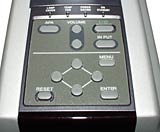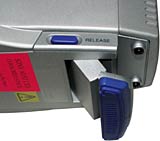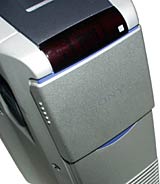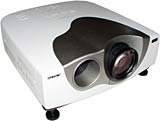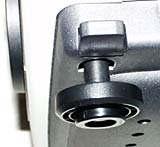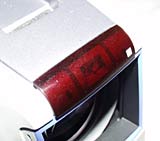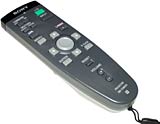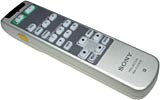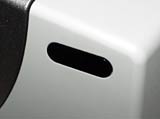
Sony VPLPX1 and VPLVW10HT LCD projectors
Review date: 11 April 2000.Last modified 03-Dec-2011.
Want a video projector with the features of a big serious business unit, but the size and weight of a (slightly misshapen) lunchbox?
Or would you rather have a widescreen TV the size of your wall, with enough resolution to do a decent job with HDTV, that you can easily pick up and stick under the couch when you've finished watching the movie?
Well, Sony can help you out, with these two LCD video projectors. One's aimed at people who want to be able to deliver punchy presentations on the go, and the other's meant for home theatre nuts. But they both do a pretty good job for anything - business graphics, movies, or even computer or console games, as long as you're not afraid of a screen that approaches the size of Texas.
The VPLPX1 is the little one. It's an impressive piece of gear. It's got 1024 by 768 resolution, an imposing 1000 ANSI lumen brightness rating, and it only weighs four kilograms. It's just 108mm wide, 223mm high and 337mm deep.
This might not quite qualify it as an "ultraportable", like the 2.9 kilogram VPLCS1 (reviewed here), but its elegant, comfortable pop-out handle means that the PX1 is, really, still about as portable as anybody needs a projector to be.
The simple, compact PX1 control panel.
A pop-down foot at the front of the PX1 gives a bit of aiming flexibility; it's got a few possible positions short of this fully-down one.
The unusual "upright" design of the VPL-PX1 means it takes up very little desk space. It also increases the chance that it'll be able to shoot over obstacles, and gives it a slightly straighter aim at a vertical screen, which reduces "keystone" distortion.
A sliding door protects the lens when the VPLPX1's not in use.
The PX1, like many current Sony products, has a casing chiefly made of an ultra-light, very strong magnesium alloy. This lets it use a lower powered, quieter cooling fan, because the whole casing can be used as a heat sink for the high powered lamp. The projector gets quite warm in use, but not alarmingly so.
But you've got to pay to play. The VPLPX1 retails for a hefty $AU12,078, including tax.
If you're willing to put up with a bigger box, you can get considerably more performance for a bit less money. The heftier VPLVW10HT is a multi-purpose projector, also using LCD technology, but with a 1366 by 768, 16:9 aspect ratio display, against the conventional 4:3 aspect ratio of the VPLPX1. It's rated for 1000 ANSI lumen brightness, too, but only in 16:9 mode.
The 10HT is perfectly happy to display 4:3 aspect ratio video; it does it at the same resolution as the PX1, using just the middle 1024 columns of its display. It simply leaves the edges blank. You can also set it to stretch 4:3 input to 16:9, which will strangely squish normal video, but works perfectly with systems that are outputting a horizontally compressed 16:9 signal through 4:3 video hardware.
The 10HT can adroitly deal with all sorts of widescreen/narrowscreen conversion situations, like this. It's meant to be a home theatre projector, but it's got dual, switchable, RGB/component video inputs as well as the normal home theatre composite and Y/C input connectors. So you can actually connect it to pretty much anything. Desktop or laptop computers, home or professional VCRs, DVD players, game consoles - you name it.
And the VW10 may be rather more than twice the size of the VPLPX1, but it only weighs eight kilograms. You're not going to find a CRT projector - the next step up, in quality and price, from LCD - that weighs in at less than about 30 kilos; the 10HT's a featherweight, by comparison.
The VW10 control panel is easy to use, and has a "light" button to illuminate it.
The VW10 doesn't have as snazzy a case as the PX1 - although its styling is still rather swish. It deals with cooling in the traditional way, with a nice big fan.
Unusually, though, the fan exhaust is mounted on the front of the projector. This is actually rather sensible - it means the hot air from the fan isn't going to be blowing in anyone's ear, and it sends the fan noise forward, as well.
Not that there's a lot of noise, in any event; the VW10 is pretty quiet even when running at full power. If you switch it into its lower powered "Cinema Black" mode, the fan slows down too, and it's barely audible even if you're not watching a movie featuring Arnold Schwarzenegger and platoons of self-propelled 380mm rocket mortars.
With two independent screw-adjust front feet, the VW10 gives you fine vertical aim, but not much total tilt range.
For all its extra features, the VW10 still costs less than the PX1. Miniaturisation is expensive, and the VPLVW10HT has less of it; it's a mere $AU11,956 retail, including tax.
Sticker shock
Now, that means that both of these projectors are well out of the price range of most buyers.
You can get portable business projectors - like the VPLCS1 - for less than half of the price of the VPLPX1. But the PX1 has superior resolution (the CS1 is only 800 by 600), and very high brightness (only 600 ANSI lumens for the CS1). Whether this is worth the extra money, I leave as an exercise for the reader.
For the price of the cheaper VW10, you can get a couple of CS1s and some change, or a truly monstrous television.
But monstrous is definitely the right word for giant-screen TVs; they eat a huge chunk of floor space, and they're about as easy to move as an upright piano. You can get hang-on-the-wall plasma display 16:9 TVs, but they cost even more than the VW10 and don't give you anything like the image size.
The VW10 can't, really, be described as portable, but at only eight kilos and with dimensions of 395 by 168 by 427mm (HxWxD), it's easy for one person to move. A proper screen is nice, but anywhere with a white wall will do as a screening room for either of these projectors. The VW10, in particular is as at home in the boardroom as it is being carted to someone's house for a movie night.
As I'm wont to do in reviews of Very Expensive Objects, I'll just assume from now on that the price doesn't frighten you. Assuming you've got the money and don't mind spending it, which of these two should you pick for what jobs?
Screen size
How big a screen a projector can throw an image on is determined vaguely by its brightness - the bigger the screen, the dimmer the image - and more definitely by its focus and zoom capacity. The PX1 is therefore rated for a 40 to 200 inch diagonal display. The VW10's rated for 40 to 300 inch diagonals, but that's in 16:9 aspect ratio; in 4:3, it's more like a 245 inch diagonal.
That's still pretty big, though. A better than 6.2 metre diagonal 4:3 image is considerably more than you can fit onto most walls.
In reality, both projectors are likely to be used with rather smaller screen sizes, to keep the brightness up. But, in a dim room, they can both throw a quite watchable image at their maximum screen sizes, which is impressive from the VW10 and verges on amazing from the tiny PX1.
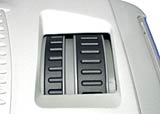
The big, comfortable PX1 focus and zoom rings
are accessible from both sides of the projector.
Both projectors have manual-zoom, manual-focus lenses that make it easy to set them up to match normal screen and wall sizes in pretty much any room. The PX1 has a 1.3 times zoom, and the VW10 only 1.2X; this may not sound like much, but the lenses are built for pretty close focus already, so you won't need to knock down a wall to get the projector far enough from the screen for a big picture.

The larger lens of the VW10 is as easy to adjust as the PX1's.
The VW10, incidentally, also has an optional support that lets you hang it from the ceiling, if you like.
Neither projector has optional zoom lenses, for hole-in-the-wall, long-throw mounting.
Image quality
Generally speaking, both of these projectors give an excellent image, by LCD standards. But that last phrase is the catch. If you know what to expect from an LCD projector you'd be well pleased with Sony's offerings, but if you expect a TV-like image on your wall, you'll be disappointed.
This is because LCDs have one big problem. They can't do black.
The basic design of the LCD projector has a great big lamp shining through three panels - one for each colour. When a pixel's meant to be black, the panels try their hardest to be opaque, but they just can't do it. The result is a rather high "black level" - the darkest an LCD can manage just isn't that dark. You can't really do anything about this.
Both of these projectors have contrast adjustment and a "Dynamic Picture" higher-contrast mode that looks nice for video. But the grey-black problem remains.
Sony don't quote contrast ratios for their LCD projectors. The contrast ratio is the ratio between the darkest black and the whitest white; a display device that's capable of emitting not one photon when it's meant to be black will score an infinite contrast ratio.
Sony say they don't quote ratios because nobody's come up with a standardised way to measure them, but that's just a smokescreen. They don't quote 'em because LCD projector contrast ratios always suck, and the brighter the projector, the crummier the ratio tends to be.
Both of these projectors can punch a viewable image out in quite brightly lit rooms; the lamps are certainly powerful. But the down side is rather grey blacks, and somewhat washed out colours generally. Put the VW10 in Cinema Black mode, cutting the lamp power, and you get a less washed out image (which isn't as bright, and is therefore suited to dimmer rooms). But blacks are still nothing like as good as you'll get from pretty much any current TV.
That said, it's not as bad as it sounds. You get used to grey blacks. It's actually perfectly watchable. If you're watching a movie that's got lots of sneaking-about-in-the-dark scenes it can be a tad annoying, but it's generally quite acceptable.
But put a TV next to the projector image, even in a pitch black room, and the difference is huge.
Further nasty surprises
Contrast ratio aside, there are two other things that can spoil an LCD projected image; dust, and dead pixels. Both of the review projectors had some of each.
When dust gets into the image path of an LCD projector, you can usually see the shape of the dust particles quite clearly if you wind the projector well out of focus. The dust shows brightly in the appropriate colour for the bit of the image path it's sitting on, but most of it blurs out into invisible blobs when you actually focus the projector properly. Peer closely at a "black" screen and you can see the faint, fuzzy blobs, but they aren't noticeable against pretty much any real image.
Crud in the green path, though, can be quite noticeable. The human eye is more sensitive to green than it is to red or blue. And the review VW10 had two fairly prominent green blobs.
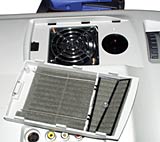
It's easy to get at the air filter for the PX1 - and a good idea
to clean it regularly.
Note the tiny speaker to the right of the fan - Big Disco Bass is not its
strong suit.
Projectors have dust filters to keep this crud out, but the filters in portable units like the PX1 are just skinny squares of foam that don't do a terribly good job. And both of these projectors had been to a trade show or two, and through the hands of one or more reviewers, before I got them. So, one way or another, they both had some contamination problems.
You can do something about dust, if it gets too bad; dismantle the projector and clean it. You should also swap dust filters regularly, to help prevent rubbish getting back in.
Dud pixels, you're stuck with.
![]()
Stuck-on green pixels like this one stick out like a dog's...
well, they're quite hard to ignore, all right?
Every single pixel on the three image panels of these projectors - red, green and blue - has a little transistor behind it to switch it. That means 2,359,296 transistors in the PX1's display, and a whopping 3,147,264 in the VW10.
Unsurprisingly, it's really difficult for LCD manufacturers to make panels with absolutely no defective transistors.
Dud transistors result in dud pixels - or, more accurately, dud "subpixels"; only if all three transistors for a given pixel are stuck on or off will that pixel be stuck white or black. Otherwise, it'll just have one of its colour components stuck, and the other two will work normally.
Stuck-off subpixels are quite hard to see, even against a white screen; stuck-on ones are much more obvious. Again, green defects are most noticeable.
The review VW10HT had only one stuck-on subpixel I could see - a blue one in the upper right quadrant.
The review VPLPX1, though, had no fewer than three stuck-on green subpixels, which is A Bad Thing, because green is much more visible than red or blue. If I were shopping for a projector, I'd have rejected this one.
Getting completely anal about dud pixels will not only make you enemies among your local projector sales staff, but may also see you go through your country's entire stock of the projector model you're interested in without ever finding one with no defects at all. Several stuck-off subpixels are no problem at all, and stuck-on red or blue subpixels are tolerable, if they're close to an edge.
My own tolerance level for stuck-on green subpixels, though, particularly in a projector that costs as much as a quite nice used car, is low.
Unexpected ugliness
As mentioned above, though, both of these projectors do an excellent job, if you accept the limitations forced of LCD technology. The utterly gigantic image size and their marvellous portability strongly encourages forgiveness of their character flaws.
The only down side is that these projectors, particularly the VW10, can throw such a gigantic, super-high-resolution image that they may make you uncomfortably aware of the inadequacies of the source material.
Non-HDTV televisions have crummy resolution. Even quite fancy ones aren't made to display a signal with a discernible resolution much higher than the 768-by-575-or-so of PAL broadcast video at standard overscan (see my video article here for more information on the minefield that is analog video resolution measurement...). So both of these projectors are actually much, much sharper than pretty much any ordinary TV.
If you're watching something in 4:3 aspect ratio, both of these projectors give you a 1024 by 768 display, for something like 80% higher resolution than a high quality TV.
When you display 16:9 video on a 4:3 device like the PX1 or a plain TV, you're only using three quarters of the available vertical resolution. The image is "letterboxed". So a 1024 by 768 projector like the VPLPX1 only actually gets to use 1024 by 576 pixels - 589824 pixels in total.
Even this, of course, still beats that snazzy TV by about a third.
The VW10, on the other hand, gets to use its full 1366 by 768 resolution for 16:9. 1049088 pixels. Almost 80% more than the VPL-PX1 can manage, and almost 2.4 times the resolution of the pricey TV. A lot of movie-video input has a wider, shorter aspect ratio than 16:9 and so is still somewhat letterboxed even on the VW10, but the widescreen projector retains its proportional advantage over plain 4:3 units.
Old 640 by 480 LCD projectors have offensively large pixels, when they're throwing a decent sized image. The "screen door" effect that results can be minimised by tweaking the projector a little out of focus, but it's still hard to miss. Sony's own earlier W400Q 1068 by 480 pixel 16:9 projector (the only widescreen LCD projector on the market, until the VW10 came out) gets around this problem by using a staggered grid of pixels - offsetting the rows so they don't line up perfectly above each other.
The more recent Sony's don't use this trick, though; they're square-grid all the way. Which is just as well, as staggered-grid looks lousy for computer graphics.
800 by 600 is substantially better than 640 by 480. It delivers excellent results with VHS video, and quite acceptable DVD playback - you can see the pixels, but they're not very annoying.
1024 by 768 is up to the challenge of DVD. NTSC DVDs are usually 720 by 480, by the way; PAL is usually 720 by 576. The projector pixels are barely visible, and having a fair few "extra" pixels allows a good accurate rendering of the DVD image, without much loss of detail from pixel overlap effects.
1366 by 768 has pixels just as small as 1024 by 768, of course, if the vertical image size is the same. But if you're watching 16:9 video, the fact that the entire display gets used means that more of those pixels get used for the image, giving an even finer grained result.
At this resolution, the projection system fades into the background, and you get to examine the true magnificence of... the nasty compression artefacts in your DVDs.
The Iron Giant, for instance, looked great when I watched it through the little VPLCS1. Sure, it was a bit dim, and the pixels were a bit big, but it was thoroughly watchable.
Feed it through the far more capable VW10HT, though, and suddenly the MPEG greeblies around the big blocks of colour in this animated movie became glaringly obvious. They were almost completely invisible on a high quality TV, but they jumped out and did offensive victory dances when the image took up a wall.
Using the old unfocus-the-projector trick helped considerably, but the artefacts still didn't vanish.
Fortunately, cel animation is a worst case scenario. It's full of high contrast transitions between black-outlined things, and it's just these sorts of situations where MPEG-2 compression, as used in DVDs, falls down. Other movies looked much better, even with the projector focussed to razor sharpness; if you were picky about it, it was easy to see artefacts in the VW10's picture, and even the PX1's. But softening the focus just a little and concentrating on the movie, rather than whether that soft-focus building in the background had a slightly weird look about its top edge, solved the problem.
If you've got source material with defects - whether it's the painfully low resolution of VHS, or poorly encoded or over-processed video on DVDs - there's nothing that'll accentuate the problems like putting the picture on a screen the size of a tennis court. But you can't blame the projector for that.
Resolutions
No LCD display device can deal elegantly with resolutions different from its physical pixel grid size. If you display a lower resolution than the physical number of pixels, the only way to get a full-screen display is by interpolating new pixels from the colours of the existing ones, which looks odd and lumpy at best. The alternative is to just display the under-sized image with a black border.
Try to display a higher resolution than the physical number of pixels, and the display device has to average out input pixels that overlap one physical pixel to determine its colour. This, also, looks crummy.
That said, it's nice when a projector can handle high resolutions, even if it does it in an ugly way; that way, when you're using the projector as your only display device, you don't get stuck with a black screen if you send the poor thing more than it can handle.
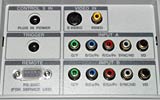
The VW10 connector panel lacks 15 pin computer inputs,
but you can use a VGA-to-RCA lead to connect to either
of the two sets of RGB/component inputs. There's a 12 volt
trigger jack output, too, for home theatre people who want
to trigger their show-off motorised curtain and other techno-toys
when the projector's powered up.
The VPLVW10HT can handle up to 1280 by 1024 computer input (compressed and ugly, but displayable). Any RGB signal from 15 to 91kHz scan frequency, refresh rate 50 to 85Hz, is OK. And it explicitly supports four of the standard Advanced Television Systems Committee (ATSC) Digital Television (DTV) modes - 480i (interlaced, like plain TV), 480p (progressive scan, like non-interlaced computer displays), 720p and 1080i. NTSC, PAL, SECAM; no problem.
The PX1 is a bit pickier; it can only take 15kHz, or 24 to 91kHz, RGB. Again, with a 50 to 85Hz refresh rate. Again, you can display 1280 by 1024 if you're happy to put up with unsightly compression.
Remote control
Both projectors let you set up pretty much everything but the focus and zoom - which are manual - from the remote control.
The VPLPX1 has IR receivers front...
...and rear.
The PX1's business presentation target market means it comes with a special connector for a PS2 mouse lead, which you can plug into a PC or laptop. The projector is now, as far as the computer's concerned, a mouse, and you can fairly easily control your presentations from the projector's buttons or the remote control - which has a phaser-ish index finger trigger button for left-clicking. The VW10 doesn't have the mouse-remote feature.
The VPLPX1's remote also comes with a built-in laser pointer, for highlighting the salient points of your quarterly sales graph or blinding that fellow in the back row who isn't paying attention. If you want similar functionality for the VPLVW10HT, you'll have to shell out ten bucks for a separate pointer.
The only special feature of the VW10 remote control is the yellow button on the side - which lights up the other buttons.
But the VW10 remote also allows easy access to the six video setting memories - you can pre-configure the VW10's image settings for half a dozen different signal sources, and switch easily to that collection of settings with the push of a button. You can do it from the control panel on the projector, as well, but there's more pose value in using the remote.
The VW10 has twin IR receivers, too; one small oval one on the front...
...and one big Star Trekky one on the back.
Keystone correction
Both projectors have digital keystone correction, which lets you compensate for the trapezoidal image shape you get when a projector's looking up (or down) at the screen. Digital keystone correction does the job by throwing away data, though; it just shortens the lines at the end of the picture you've asked it to narrow, and averages out pixels that get squished together. It's quite obnoxious for sharp computer graphics, especially vertical lines; it's less nasty for video.
Fortunately, there are two ways to minimise keystone problems without having to resort to digital correction. You can get a decent quality screen with tilt adjustment, so you can aim the screen down at the projector. Or you can just put the projector far enough from the screen, and/or far enough up, that there's little to no keystoning even with the screen vertical. A degree or two of keystoning is hard to notice - remember, you get the same sort of distortion when you're not sitting directly in front of a television, and people put up with that happily enough.
Sound
The VPLPX1, as befits its business-projector role, has a pair of teeny-tiny speakers built into its sides. They're not very loud, and they have no bass at all, but they'll do in a pinch. At least they're not drowned out by the cooling fan.
The VW10 doesn't insult its buyers with built in sound. Home theatre people already have a room full of speakers. If you're using it for business presentations, you'll need a separate audio rig - but even the crummiest $20 set of computer speakers will sound better than the built in PX1 ones.
Running costs
In the olden days, LCD projectors tended to cost rather a lot to run, because their lamps were expensive and didn't have very impressive life spans.
Well, the lamps are still expensive, but now at least they last for ages. And both projectors, like all decent units these days, have an easily accessible lamp life counter in the setup menu, so you know when it might be prudent to swap in a new unit.
The lamp assembly for the PX1 will set you back no less than $AU713.70 retail, including tax. A heck of a lightbulb, I think you'll agree.
Fortunately, you can expect that lamp to last for 2000 hours. You'll only be paying about 36 Australian cents per hour.
The VW10's lamp assembly costs an even more exciting $878.40, and it's got the same expected life; about 44 cents an hour. If you switch the projector to Cinema Black Mode, though, Sony say you'll roughly double the lamp life. So if the VW10's used exclusively in Cinema Black mode for, say, a two hour movie every single night, seven days a week, you can expect five and a half years of service out of the thing.
Overall
Between these two, I have to say the VPLVW10HT is the stand-out winner, overall, unless you must have a very portable projector. If you don't need a projector that can fit in carry-on luggage, the VW10 has more pixels, more flexible inputs, far better widescreen performance, and a lower price tag. What's not to like?
Moving the PX1 around is, of course, effortlessly easy. But you really can, without much trouble, shift the VW10 as well. Even small CRT projectors are, at best, "transportable" - which translates as "neither bolted to the floor nor attached to an alarm system". But carting the VW10 up three floors to a different meeting room or off to someone else's house for a party should be no trouble for any able-bodied person. It only weighs as much as fur two-litre jugs of milk. And it's warmer.
The PX1 is easily the most elegant tiny projector I've seen, not to mention the most packed with big-projector features. But it's even more expensive than the VW10, and a lot of projector buyers just don't really need that much portability. Its tinyness, for many businesses, will just make it easier for the work experience kid to steal.
On the other hand, the PX1's neat design also makes it easier for the lucky worker that wins the weekly raffle to take it home for the weekend.
Both of these projectors are great all-rounders, but if you can stand its size, the VW10 is the better of the pair. Cheap they aren't; good they are. Recommended.
Review projectors kindly supplied by Sony Australia


